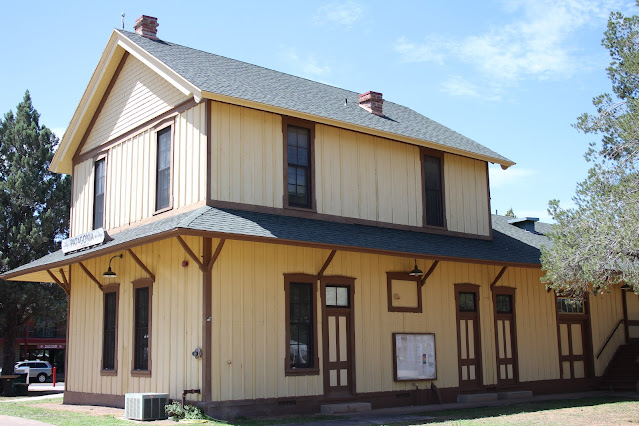Subtly funky Patagonia, situated between Nogales and Sonoita on southern Arizona's Highway 82, might just be my new favorite little Arizona town, the epitome of adorable. With a history tracing back to Jesuit Father Eusebio Kino's forays into the region in the 1500s, parts of the town reflect the Spanish influence. The train depot, though, is pure turn-of-the-century western, while the small, square, concrete Marshall's Office and jail are 1920s WPA (Works Progress Administration). Other structures hearken back to 1950s road-trip culture, and the Velvet Elvis Pizza Shop adds just-enough-modern-funk to be charming and yet not so much to be ruined by its own preciousness. Open roads in each direction are rich with pre-territorial and territorial-era military history and are pure joy to drive for the varied open terrain. Even on this mid-July Arizona day, when Phoenix-area temperatures rose to 114, at 4050 foot elevation, Patagonia was ideal - the kind of day you'd say, "Yeah, let's sit outside for a while," and enjoy the green hillside views brought to you courtesy of this year's monsoon.
The American West, old and new, offers fertile ground for a dreamer's imagination. Here, visit the settings of past range wars or gunfights; take a trip back to the average person's daily life in the old west; or learn about historical episodes. Amazon affiliate: Author may receive compensation for Amazon products linked on this site.
Monday, July 11, 2022
Perfectly Patagonia
The town's name derives from the Spanish and means "big foot." Some early sources said it was so called for the distinctively big feet of local Indians. The town itself was named after the nearby Patagonia Mountains, which were named after the Patagonia Mine, which had been so-named in 1859 by Lt. Sylvester Mowry, who purchased the mine from a Mexican. The naming origin gets more confusing, though: Originally, Patagonia indicated the post office founded in 1866 at the Mowry Mine, ten miles to the south; the first postmaster at that location was Lt. Mowry's brother, Charles.
A Pennsylvanian and Civil War veteran by name of Rollen Rice Richardson, made wealthy by eastern oil money, bought large ranch holdings in the region, including Monkey Springs Ranch and the abandoned Camp Crittenden. By 1890, Richardson and his two partners had a vast cattle enterprise but the drought devastated the enterprise. Richardson sold out everything but 500 acres which included the site of today's town of Patagonia. Richardson moved the town of Crittenden, residents and all, to the site in 1896. Sadly for Richardson's legacy, the townspeople refused to support his quest to name the town (via name of the post office) Rollen, but in a turn of good luck for lovers of appealing and interesting names, they chose the name Patagonia for their new town, co-opting the name from the previous post office at the mine. The post office at the current Patagonia was established in 1900 under the oversight of postmistress Mamie M. Cretin.
The mine itself had been a rich source of silver and lead deposits, and Lt. Mowry himself - recently retired from the U.S. Army - was accused by the military of using the mine's lead to make bullets, which he sold to the Confederacy. Lt. Mowry was arrested, charged with treason, and held at Fort Yuma, and the mine confiscated by the Army. Lt. Mowry was never court-martialed and later sued the federal government and culpable army staffers in vain. The marker above is in front of the train station at Patagonia.
The train station, built in 1900, stood along the now-abandoned tracks that were built in the 1880s to connect Nogales to Benson. The peak of the railroad's use came during World War II, when thousands of tons of ore were shipped out of the area's mines each month to support the war effort. As the mines shut down, a preservation-minded citizen, recognizing the significance of the train depot, purchased it.
By the 1930s, the Mowry Mine townsite was a ghost town, but the Works Progress Administration brought some work to the area: the small town jail above was built by WPA crews. The WPA also hired authors to chronicle America and its history; their volume on 1930s Arizona included visits to Patagonia and neighboring areas.
At the time of the WPA writers' visit, the town boasted 500 residents, considerably more than the 133 who occupied the town when the train station was built. Throughout these decades, the community's Methodist Church, shown below, served the faithful. Built around 1923 by local residents, the elegant stained glass windows were added by local artist Jean Burger in the late 1980s throughout the 1990s. According to the plaque to the left of the door, the window shown here is called "Cross Window and White Rose" and employs the "Tiffany method of stained glass art."
Across the main road of town, look for the wonderful PIGS station below, a throwback to rural stations of mid-century roadtrips. What's not to love about Patagonia? Even at today's record-high gas prices, a roadtrip to Patagonia - and while you're at it, nearby Sonoita and Elgin - is worth the time and money. If you're from the Phoenix or Tucson metro area, you'll feel like you're in an entirely different state - and no matter where you're from, you'll feel like you're a time traveler visiting an entirely different era.
Copyright (c) 2022 Marcy J. Miller * All rights reserved * No part of this content, including photographs, may be used without the express permission of the author * Links and shares, however, may be freely shared and are appreciated. All photographs by Marcy J. Miller.
Partial list of sources:
Will C. Barnes, Arizona Place Names, 1960 edition
The WPA Guide to 1930s Arizona
John and Lillian Theobald, Arizona Territory Post Offices and Postmasters, 1961
Ray Brandes, Frontier Military Posts of Arizona, 1960
Arizona Highways Magazine
On-site placards and historical markers
Subscribe to:
Post Comments (Atom)








No comments:
Post a Comment